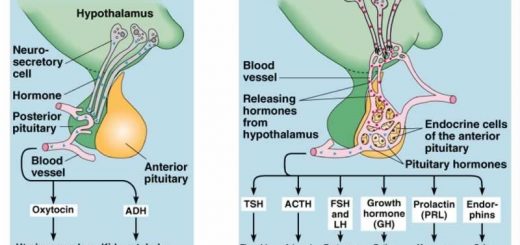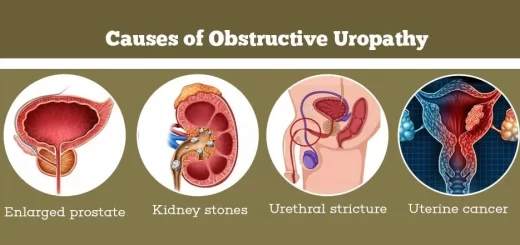Neoplastic diseases of the urinary tract, Tumors of the kidney and Renal cell carcinomas
Many types of benign and malignant tumors occur in the urinary tract, They can arise from the kidney parenchyma or pelvicalyceal system or lower urinary tract. Tumors of the kidney may arise from renal parenchyma or from the renal pelvis.
Tumors of the kidney
I. Tumors of the renal parenchyma.
A. Benign Tumor (rare), They include oncocytoma and angiolipoma.
B. Malignant Tumors (common).
- Renal cell carcinoma (hypernephroma)
- Nephroblastoma (Wilms tumor) II, Tumors of the renal pelvis (urothelial tumors)
Oncocytoma
- The benign neoplasm arises from the intercalated cells of collecting ducts.
- Represents about 10% of renal neoplasms.
Morphology
Grossly: Tan-colored (mahogany color- reddish brown) with a central stellate scar
Microscopically: Oncocytic cells with granular eosinophilic cytoplasm (due to numerous mitochondria).
Renal cell carcinoma
It is the main tumor of the kidney representing about 90% of all malignant renal tumors.
- Origin. It arises from the renal tubular epithelium (adenocarcinoma).
- Age. It is most common in the 6th, and 7th decades of life; however rare cases are diagnosed in children.
- Gender.: Male to female ratio is 2:1.
Risk factors
- Smoking, hypertension, obesity.
- Occupational exposure to cadmium.
- The risk is increased 30-fold in individuals with acquired polycystic disease as a complication of chronic dialysis.
- Genetic factors may play a role in its causation.
Classification
Renal cell carcinomas are classified based on:
- Morphology and growth patterns.
- Genetic alterations.
The three most common types are:
- Clear cell renal cell carcinoma.
- Papillary renal cell carcinoma man.
- Chromophobe renal cell carcinoma.
Clear cell RCC
- The most common (65% of renal cancers).
- Associated with alterations of the VHL tumor suppressor gene.
- Occurs in sporadic and familial forms.
- Histologically, they are composed of cells with clear cytoplasm.
Morphology
Grossly:
- The tumor may arise from anywhere in the cortex.
- It appears as a solitary and large spherical mass 3-15 cm in diameter.
- The margins are well defined sometimes with small satellite nodules (multifocal).
- CS reveals a variegated appearance formed of bright yellow-gray and white tissue that distorts renal parenchyma and renal outline with prominent areas of cystic softening or of hemorrhage either fresh or old.
- The tumor may invade the renal vein.
Microscopically
- Tumor cells are arranged in nests with delicate highly vascular stroma.
- Cells are rounded or polygonal in shape and mostly have abundant clear cytoplasm (due to glycogen and lipid) and small regular nuclei.
- Areas of necrosis and hemorrhage are also seen.
Grading of RCC:
WHO/International Society of Urological Pathology (ISUP) grading system for clear cell renal cell carcinoma and papillary renal cell carcinoma.
- Grade 1: Nucleoli are Invisible or small and basophilic at high power (x400).
- Grade 2: Nucleoli are visible and eosinophilic at high power (x400).
- Grade 3: Nucleoli are visible and eosinophilic at low power (x100).
- Grade 4: Extreme nuclear pleomorphism, multinucleated giant cells. and/or rhabdoid and/or sarcomatoid differentiation.
Tumor spread
- Direct spread: As the tumor enlarges, it may Fungate into the pelvicalyceal system and ureter, it may invade into the perinephric fat, and it may invade into the adrenal gland.
- Blood spread: Even more frequently, the tumor invades the renal vein and grows a solid column within this vessel, sometimes extending in a serpentine fashion as far as the inferior vena cava and even into the right side of the heart, Distant metastases, commonly to lungs and bones, (Note. RCC is one of the exceptions that tend to send early metastasis by blood.
- Lymphatic spread.
Clinical features
The characteristic triad of painless profuse total hematuria, dull flank pain, and palpable abdominal mass. The tumor may remain silent (occult) and manifests itself by lung and bone metastasis.
Extra-renal effects and paraneoplastic syndromes:
- Fever.
- Polycythemia (5-10%) results from the production of erythropoietin by the cancer cells.
- Uncommonly, these tumors produce other hormone-like substances;
- resulting in hypercalcemia, and hypertension. Cushing syndrome; or feminization or masculinization.
You can subscribe to science online on Youtube from this link: Science Online
You can download Science Online application on Google Play from this link: Science Online Apps on Google Play
Urinary tract obstruction symptoms, causes and obstructive lesions of urinary tract
Urinary bladder structure, function, Control of micturition by Brain & Voluntary micturition
Urinary passages function, structure of Ureter, Urinary bladder & Uvulae vesicae
Control of water balance in your body, Regulation of volume & osmolality of Body fluids
Urine formation, Factors affecting Glomerular filtration rate, Tubular reabsorption & secretion
Histological structure of kidneys, Uriniferous tubules & Types of nephrons
Functions of Kidneys, Role of Kidney in glucose homeostasis, Lipid & protein metabolism
Physical properties of urine, Tests to evaluate kidney function & Normal constituents of urine




